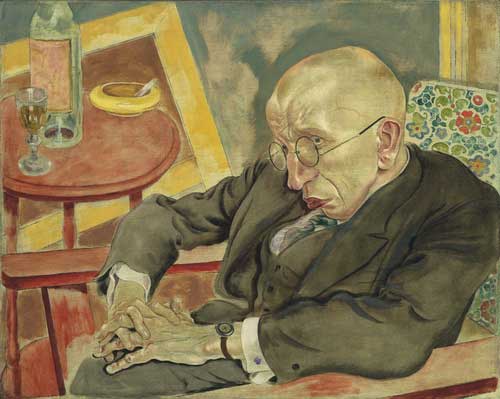Normally I do not delve into the realm of Modern Art, but today I chose to discuss the works of George Grosz. Within the field of cultural property and repatriation, scholars often find themselves discussing the morals of Nazi-Era looted art because it highlights an aspect of repatriation where we have documentation demonstrating theft.
During the buildup to World War II, thousands of pieces of art fell victim to the Third Reich either because the Nazis deemed the work degenerate and/or the owners fled persecution.
One such case making the rounds of news headlines is that of the New York Museum of Modern Art (MoMA) and 2 oil paintings by the German expressionist George Grosz.
George Grosz fled Nazi Germany to New York in 1933 after receiving threats. While in exile, the Nazi government ordered his property confiscated, including the work entitled "The Poet Max-Hermann-Neisse" (shown above). The Nazis published the confiscation of his property in 1938. In 1952, Charlotte Weilder of the Carnegie Institute sold the paintings to the MoMA after she claimed she inherited the works (artdaily.org)
At the time of purchase, Grosz lived in New York, but the museum did not inform him of the sale, in fact he first learned that the museum owned his work in 1953. He wrote to his brother-in-law, Otto Schmalhausen that 'Modern Museum exhibited a painting that was stolen from me (I am powerless against that) they bought it from someone who stole it' (artdaily.org).
Grosz died in 1959. Now after 50 years his heirs seek the return of two of his works that hang in the MoMA. MoMA declined the request, with support of the U.S. Courts, citing that the statute of limitations expired on retrieving such works (Singal 2013). According to Jesse Singal of USA Today, those seeking the return of art stolen during the years pre-dating World War II find it more difficult to obtain restitution in the U.S. than in Germany and other European countries.
The U.S. signed on to the 1998 Washington Conference Principles on Nazi-Confiscated Art. Some important points to the conference are as follows (taken from U.S. Department of State):
- In establishing that a work of art had been confiscated by the Nazis and not subsequently restituted, consideration should be given to unavoidable gaps or ambiguities in light of the passage of time and the circumstances of the Holocaust era
- Every effort should be made to publicize art that is found to have been confiscated by the Nazis and not subsequently restituted in order to locate its pre-War owners or their heirs
- Nations are encouraged to develop national processes to implement these principles, particularly as they relate to alternative dispute resolution mechanisms for resolving ownership issues
Grosz's heirs, his son and daughter-in-law Martin and Lillian Grosz, first made a formal request in 2003. MoMA stated that they have rightful ownership:
After years of extensive research, including numerous conversations with Grosz'z estate, it was evident that we did, in fact, have good title to the works by Grosz in our collection and therefore an obligation to the public to defend our ownership appropriately" (Singal 2013)Cases involving Nazi-era art become emotional, more so sometimes than those involving claims between countries and other forms of art. I bring this case up because it highlights a debate between the law and ethics. The law might not parallel ethics, and in this case is not returning Nazi-era art the ethical thing to do?
I am a little on the fence with this case for the following reasons:
- There is proof that the art was stolen during extremely traumatic period with the last century (take the publication my the Nazis in the late 1930s)
- Why would the museum want to showcase work stolen from the artist?
- Did the museum conduct due diligence of the time of purchase?
BUT
- Should the museum adhere to an agreement made by the U.S. in 1998 more than 40 years after purchase?
- If the museum returned the art, would it be lost to the public?
THEN AGAIN
- Does it even matter if the public gets to see artwork in a museum? Why is one good better than the other?
For me the jury is still out, although I am a little disappointed with MoMA's stance.
Please weigh in to share where you stand on this issue, I would appreciate thoughts.
Sources
Singal, Jesse. "Critics say US museums holding onto Nazi looted art." USA Today, December 21, 2013. http://www.cnbc.com/id/101291336 (accessed December 23, 2013).
U.S. Department of State, "Washington Conference Principles on Nazi-Confiscated Art." Last modified December 03, 1998. Accessed December 23, 2013. http://www.state.gov/p/eur/rt/hlcst/122038.htm.
"Grosz Heirs File Suit Against MoMA for Artworks Unlawfully Taken During Nazi Era." artdaily.org, December 23, 2013. http://artdaily.com/news/30252/Grosz-Heirs-File-Suit-Against-MoMA-for-Artworks-Unlawfully-Taken-During-Nazi-Era (accessed December 23, 2013).

No comments:
Post a Comment